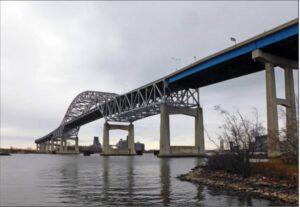This Guest Article for REVITALIZATION is by Mary Scott Nabers.
Infrastructure funding is flowing, and the majority of regional connectivity projects involve numerous stakeholders and therefore demand intensive coordination.
Under normal circumstances, these multi-jurisdictional projects would be difficult, if not impossible, to deliver in the amount of time that funding from the Bipartisan Infrastructure Bill (BIL) will remain available.
Yet recent White House initiatives are expediting review processes, promoting alternative forms of delivery, and facilitating stakeholder engagement.
In mid-October, the federal government announced it was launching new efforts to abbreviate delivery timelines for large projects, such as regional and interstate connectivity improvements.
This means large contracting opportunities will also appear more regularly.
State transportation departments for Oregon and Washington will partner on a bridge replacement project that has an estimated cost between $3.2 billion and $4.8 billion.
The new structure will replace a large, outdated bridge where Interstate 5 crosses the Columbia River. When completed, mobility throughout the region will be significantly improved.
The new bridge will include modern design, seismic resilience, and multimodal improvements to this segment of I-5. Final design work is scheduled to begin as soon as the project’s period of environmental review is concluded.
Another large bridge project, with cost projections at approximately $3 billion, will be handled by departments of transportation in Minnesota and Wisconsin.
The new John A. Blatnik Bridge, when completed, will deliver a structure that is jointly owned and managed by the two states. The bridge currently enables a daily average of more than 33,000 vehicles that cross over the St. Louis Bay on Interstate 535 between the two states.
The existing bridge was built in 1961 and is considered a critically at-risk structure. Both state transportation departments will contribute funding.
As work continues on the bi-state Blatnik Bridge project, the Minnesota Department of Transportation (MnDOT) also will begin partnering with regional entities on internal interstate projects.
One regionally scoped project, estimated to cost more than $750 million, will address transportation needs along a segment of Interstate 35 between the township of Midway and the city of Duluth.
MnDOT is collaborating with the Duluth-Superior Metropolitan Interstate Council (MIC) for the project’s ongoing community engagement phase. Findings from this process will drive the design work, scheduled to start in December.
The final plan, expected to be completed and approved before the end of 2023, will highlight statewide priorities of mitigating congestion, improving safety, and facilitating multimodal access. A steering committee will be created to advise MIC and MnDOT through delivery of the plan.
The Missouri Department of Transportation has allocated $30 million to repair or replace as many as 34 bridges in poor condition. These targeted bridges have been in service for an average of 71 years.
The scope of work will extend across seven different counties. The state plans to use design-build delivery for the project to minimize impediments to regional travel and ensure flexibility in scheduling. The state wants all work completed by 2027.
New Hampshire’s Department of Transportation will soon begin to widen a 4.5-mile segment of Interstate 93 to include two additional lanes, one in each direction.
The project, with a cost estimate of approximately $155 million, will be designed to mitigate congestion and improve mobility across a vital corridor in the state. The project will also include construction of auxiliary lanes in each direction between designated interchanges to support emergency vehicles. This project will launch in 2023.
The Nevada Department of Transportation is embarking on a $335 million project to address deficient roads, traffic congestion, connectivity challenges, and safety concerns in the southern area of the state.
This project will include reconstruction of interchanges to accommodate greater traffic capacity in the area around Henderson, Nevada. An environmental study has been completed and the project is ready to launch in 2023.
In October, the Finding of No Significant Impact (FONSI) was released for the project’s preferred design-build alternative of delivery. A FONSI is a document that explains the reasons why an action will not have a significant effect on the human environment and, why, therefore, an Environmental Impact Statement will not be required. The project will be advertised to bidders in 2023.
Encouraged by recent federal initiatives, many state transportation departments are just now starting to take on many of their most expensive and complex regional transportation projects.
This article first appeared in SPI Insights. Reprinted here (with minor edits) by permission.
About the Author:
 Mary Scott Nabers is President and CEO of Strategic Partnerships, Inc.
Mary Scott Nabers is President and CEO of Strategic Partnerships, Inc.
She has decades of experience working in the public-private sector.
A well-recognized expert in the P3 and government contracting fields, she is often asked to share her industry insights with top publications and through professional speaking engagements.


